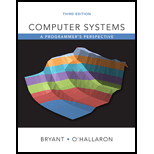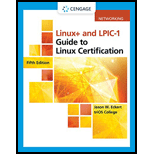
Computer Systems: A Programmer's Perspective (3rd Edition)
3rd Edition
ISBN: 9780134092669
Author: Bryant, Randal E. Bryant, David R. O'Hallaron, David R., Randal E.; O'Hallaron, Bryant/O'hallaron
Publisher: PEARSON
expand_more
expand_more
format_list_bulleted
Concept explainers
Question
Chapter 12, Problem 12.30HW
A.
Program Plan Intro
Deadlocks:
- The deadlock denotes a situation where a collection of threads remains blocked.
- It denotes waiting for a condition that would never be true.
- The progress graph denotes invaluable tool for understanding deadlock.
- If “P” and “V” operations are been ordered incorrectly, the forbidden regions for two semaphores would overlap.
- If any execution trajectory reaches deadlock state “d” then no further progress will be possible.
- In this case each thread waits for the other one for a “V” operation that never occurs.
- The overlapping forbidden regions would induce a set of states called “deadlock region”.
- The deadlock is inevitable is trajectory touches a state in deadlock region.
- Once it enters deadlock regions, the trajectories could never leave.
Mutex lock ordering rule:
- A program is deadlock-free if each thread acquires its mutexes in order.
- It releases them in reverse order and given a total ordering for all mutexes.
- The mutex should be achieved in order to ensure deadlock free scheme.
B.
Program Plan Intro
Deadlocks:
- The deadlock denotes a situation where a collection of threads remains blocked.
- It denotes waiting for a condition that would never be true.
- The progress graph denotes invaluable tool for understanding deadlock.
- If “P” and “V” operations are been ordered incorrectly, the forbidden regions for two semaphores would overlap.
- If any execution trajectory reaches deadlock state “d” then no further progress will be possible.
- In this case each thread waits for the other one for a “V” operation that never occurs.
- The overlapping forbidden regions would induce a set of states called “deadlock region”.
- The deadlock is inevitable is trajectory touches a state in deadlock region.
- Once it enters deadlock regions, the trajectories could never leave.
Mutex lock ordering rule:
- A program is deadlock-free if each thread acquires its mutexes in order.
- It releases them in reverse order and given a total ordering for all mutexes.
- The mutex should be achieved in order to ensure deadlock free scheme.
C.
Program Plan Intro
Deadlocks:
- The deadlock denotes a situation where a collection of threads remains blocked.
- It denotes waiting for a condition that would never be true.
- The progress graph denotes invaluable tool for understanding deadlock.
- If “P” and “V” operations are been ordered incorrectly, forbidden regions for two semaphores would overlap.
- If any execution trajectory reaches deadlock state “d” then no further progress will be possible.
- In this case each thread waits for the other one for a “V” operation that never occurs.
- The forbidden regions that are overlapping would induce a set of states called “deadlock region”.
- The deadlock is inevitable is trajectory touches a state in deadlock region.
- Once it enters deadlock regions, the trajectories could never leave.
Mutex lock ordering rule:
- A program is deadlock-free if each thread acquires its mutexes in order.
- It releases them in reverse order and given a total ordering for all mutexes.
- The mutex should be achieved in order to ensure deadlock free scheme.
Expert Solution & Answer
Want to see the full answer?
Check out a sample textbook solution
Students have asked these similar questions
Find the voltage V0 across the 4K resistor using the mesh method or nodal analysis. Note: I have already simulated it and the value it should give is -1.714V
Resolver por superposicion
Describe three (3) Multiplexing techniques common for fiber optic links
Chapter 12 Solutions
Computer Systems: A Programmer's Perspective (3rd Edition)
Ch. 12.1 - Prob. 12.1PPCh. 12.1 - Prob. 12.2PPCh. 12.2 - Practice Problem 12.3 (solution page 1036) In...Ch. 12.2 - Practice Problem 12.4 (solution page 1036) In the...Ch. 12.4 - Prob. 12.5PPCh. 12.4 - Prob. 12.6PPCh. 12.5 - Prob. 12.7PPCh. 12.5 - Prob. 12.8PPCh. 12.5 - Prob. 12.9PPCh. 12.5 - Prob. 12.10PP
Ch. 12.6 - Prob. 12.11PPCh. 12.7 - Prob. 12.12PPCh. 12.7 - Prob. 12.13PPCh. 12.7 - Prob. 12.14PPCh. 12.7 - Prob. 12.15PPCh. 12 - Prob. 12.20HWCh. 12 - Derive a solution to the second readers-writers...Ch. 12 - Prob. 12.22HWCh. 12 - Prob. 12.23HWCh. 12 - Prob. 12.24HWCh. 12 - Prob. 12.25HWCh. 12 - Prob. 12.26HWCh. 12 - Some network programming texts suggest the...Ch. 12 - Prob. 12.28HWCh. 12 - Prob. 12.29HWCh. 12 - Prob. 12.30HWCh. 12 - Implement a version of the standard I/O fgets...Ch. 12 - Prob. 12.32HWCh. 12 - Prob. 12.33HWCh. 12 - Prob. 12.34HWCh. 12 - Prob. 12.35HWCh. 12 - Prob. 12.36HWCh. 12 - Prob. 12.37HWCh. 12 - Prob. 12.38HWCh. 12 - Prob. 12.39HW
Knowledge Booster
Learn more about
Need a deep-dive on the concept behind this application? Look no further. Learn more about this topic, computer-science and related others by exploring similar questions and additional content below.Similar questions
- Could you help me to know features of the following concepts: - commercial CA - memory integrity - WMI filterarrow_forwardBriefly describe the issues involved in using ATM technology in Local Area Networksarrow_forwardFor this question you will perform two levels of quicksort on an array containing these numbers: 59 41 61 73 43 57 50 13 96 88 42 77 27 95 32 89 In the first blank, enter the array contents after the top level partition. In the second blank, enter the array contents after one more partition of the left-hand subarray resulting from the first partition. In the third blank, enter the array contents after one more partition of the right-hand subarray resulting from the first partition. Print the numbers with a single space between them. Use the algorithm we covered in class, in which the first element of the subarray is the partition value. Question 1 options: Blank # 1 Blank # 2 Blank # 3arrow_forward
- 1. Transform the E-R diagram into a set of relations. Country_of Agent ID Agent H Holds Is_Reponsible_for Consignment Number $ Value May Contain Consignment Transports Container Destination Ф R Goes Off Container Number Size Vessel Voyage Registry Vessel ID Voyage_ID Tonnagearrow_forwardI want to solve 13.2 using matlab please helparrow_forwarda) Show a possible trace of the OSPF algorithm for computing the routing table in Router 2 forthis network.b) Show the messages used by RIP to compute routing tables.arrow_forward
- using r language to answer question 4 Question 4: Obtain a 95% standard normal bootstrap confidence interval, a 95% basic bootstrap confidence interval, and a percentile confidence interval for the ρb12 in Question 3.arrow_forwardusing r language to answer question 4. Question 4: Obtain a 95% standard normal bootstrap confidence interval, a 95% basic bootstrap confidence interval, and a percentile confidence interval for the ρb12 in Question 3.arrow_forwardusing r languagearrow_forward
- using r languagearrow_forwardusing r language Obtain a bootstrap t confidence interval estimate for the correlation statistic in Example 8.2 (law data in bootstrap).arrow_forwardusing r language Compute a jackknife estimate of the bias and the standard error of the correlation statistic in Example 8.2.arrow_forward
arrow_back_ios
SEE MORE QUESTIONS
arrow_forward_ios
Recommended textbooks for you
 Systems ArchitectureComputer ScienceISBN:9781305080195Author:Stephen D. BurdPublisher:Cengage Learning
Systems ArchitectureComputer ScienceISBN:9781305080195Author:Stephen D. BurdPublisher:Cengage Learning Microsoft Visual C#Computer ScienceISBN:9781337102100Author:Joyce, Farrell.Publisher:Cengage Learning,
Microsoft Visual C#Computer ScienceISBN:9781337102100Author:Joyce, Farrell.Publisher:Cengage Learning, C++ Programming: From Problem Analysis to Program...Computer ScienceISBN:9781337102087Author:D. S. MalikPublisher:Cengage Learning
C++ Programming: From Problem Analysis to Program...Computer ScienceISBN:9781337102087Author:D. S. MalikPublisher:Cengage Learning LINUX+ AND LPIC-1 GDE.TO LINUX CERTIF.Computer ScienceISBN:9781337569798Author:ECKERTPublisher:CENGAGE LProgramming Logic & Design ComprehensiveComputer ScienceISBN:9781337669405Author:FARRELLPublisher:Cengage
LINUX+ AND LPIC-1 GDE.TO LINUX CERTIF.Computer ScienceISBN:9781337569798Author:ECKERTPublisher:CENGAGE LProgramming Logic & Design ComprehensiveComputer ScienceISBN:9781337669405Author:FARRELLPublisher:Cengage EBK JAVA PROGRAMMINGComputer ScienceISBN:9781337671385Author:FARRELLPublisher:CENGAGE LEARNING - CONSIGNMENT
EBK JAVA PROGRAMMINGComputer ScienceISBN:9781337671385Author:FARRELLPublisher:CENGAGE LEARNING - CONSIGNMENT

Systems Architecture
Computer Science
ISBN:9781305080195
Author:Stephen D. Burd
Publisher:Cengage Learning

Microsoft Visual C#
Computer Science
ISBN:9781337102100
Author:Joyce, Farrell.
Publisher:Cengage Learning,

C++ Programming: From Problem Analysis to Program...
Computer Science
ISBN:9781337102087
Author:D. S. Malik
Publisher:Cengage Learning

LINUX+ AND LPIC-1 GDE.TO LINUX CERTIF.
Computer Science
ISBN:9781337569798
Author:ECKERT
Publisher:CENGAGE L

Programming Logic & Design Comprehensive
Computer Science
ISBN:9781337669405
Author:FARRELL
Publisher:Cengage

EBK JAVA PROGRAMMING
Computer Science
ISBN:9781337671385
Author:FARRELL
Publisher:CENGAGE LEARNING - CONSIGNMENT